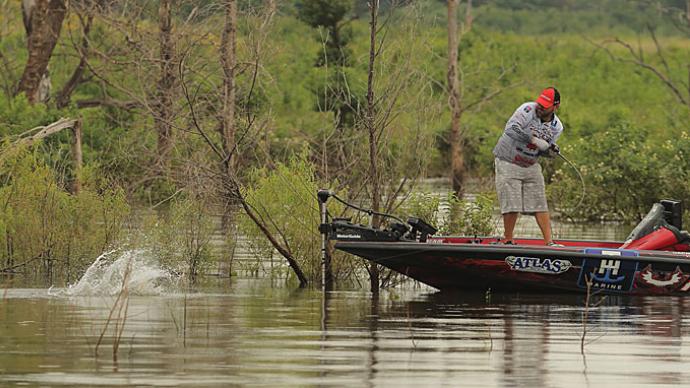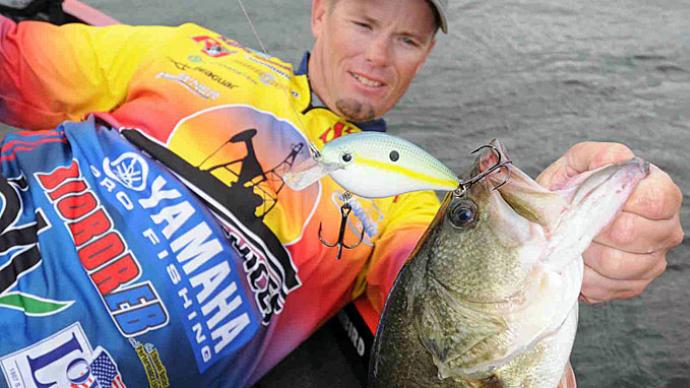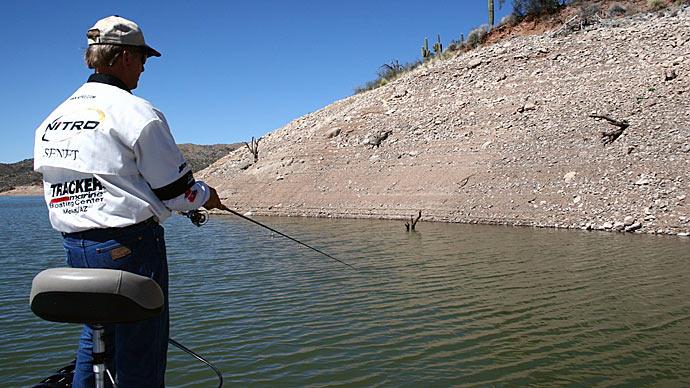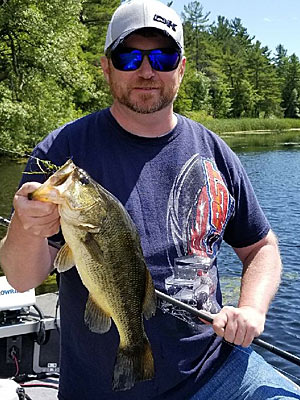
The St. Lawrence River has always been my favorite place to fish. Its combination of history, scenery, and bass are unmatched. It’s beautiful in fall when leaves turn colors, and big smallmouth and largemouth put on the feedbag before winter, which is rough along the border of New York and Ontario, Canada. But for a long time, “The River,” affectionately known by those who regularly visit, always fell down my list of favorites when summer rolled around again. Eventually, I learned there was just more to like.
Despite its system of locks and dams, the St. Lawrence’s water level slowly drops from summer onward most years. When the water level is lower in fall, bass move to the deeper islands and channels. With that piece of knowledge, you can run those spots, catching bass all day long. But come early summer, those spots produce nothing when the water level is higher. Instead, bass are shallow, enjoying deeper water in bays and along the mainland. Once I figured that out, The River became a fixture at the top of my list.
All bodies of water see their levels fall for one reason or another. Tidal water, for example, falls twice each day. Lakes, reservoirs, and rivers fall slowly through most years, their lowest levels going into winter. On most man-made waterways, that is done to prepare for spring rains.
While its rate can be different, falling water affects all bass similarly. It puts them on the move. Their movement isn’t complicated. They vacate water as it becomes too shallow, moving to the next deeper piece of structure or cover. St. Lawrence largemouth, for example, leave the weedy backwaters and bays, working their way toward mid-river, stopping at rock piles and islands along the way.
Keeping up with the bass demands a general knowledge of where to find the next deeper structure and cover on the water you’re fishing and the right lures. Here are five that you should tie on when confronted with falling water levels. While no lure is a silver bullet, these will keep you headed in the right direction.
Topwater
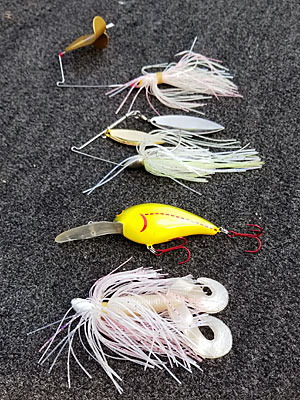
Much like the captain of a sinking ship, bass that live shallow all year long will hold onto the shore for as long as they can. So start there when searching for bass in falling water.
Topwaters, especially frogs, toads, and buzzbaits, are the best lures you can use. All three are weedless, though Texas-rigged toads and soft-bodied frogs shed vegetation slightly easier than an open-hooked buzzbait. Don’t hesitate to throw them into the thickest and shallowest cover you can find. All can be retrieved quickly, allowing you to efficiently search shallow flats, bays, pockets, and shorelines for the slightly deeper spots where these bass will make a final stand. Match your colors to the water color: lighter-colored lures in clear water and darker colors in dirty water.
This isn’t fishing for the faint of heart. Heavy cover demands 7-foot or longer medium-heavy or heavy action casting rods fitted with high-speed reels of at least a 7:1 gear ratio. Spool them with 50-pound test braided line, and don’t waste time tying up a fluorocarbon or monofilament leader. The line is entirely out of the water with these lures so that bass won’t notice it.
Spinnerbait
As the water level continues to fall, bass have to vacate their shallowest spots. If they were in the back of a pocket, for example, their next stop would most likely be about halfway between there and the main lake or creek.
When they make these first moves, sometimes to cover and structure you can’t see, spinnerbaits are your best bet to chase them down. You can fish one fast or slow, shallow or deep, and often more than one way during one cast. They are perfect for probing stretches of horizontal cover and structure such as weed edges and channel ledges. Bass follow them while retreating to deeper water.
A spinnerbait’s versatility comes from its blades. Tandem bladed spinnerbaits will cover most of your needs. Let the water color dictate which blades you choose. When it’s clear — the usual color when water is falling— go with flashy willow leaf blades. Colorado blades, which displace the most water, should be your choice in muddy water. Try Indiana blades, which blend the characteristics of the other two styles when the water color is in between.
One way to get more bites on spinnerbaits is by fishing them slightly deeper, where they are just out of your view. That puts them farther into the strike zone.
Swim jig
Swim jigs offer the versatility of a spinnerbait but in a more subtle package that’s easier to fish vertically. They are a great choice when you have followed bass to deeper water with scattered cover. You can swim the jig to each piece, pausing your retrieve long enough for it to sink into that piece of cover.
Jigs that weigh ½ ounce are perfect for fishing falling water. You can accurately cast them far. If you need yours to run shallower, change its trailer and your line. Trailers that displace a lot of water, either with bulk or kicking tails, cause a swim jig to run high in the water column. Heavier line also displaces more water, making it slower to sink. Switching to a smaller trailer and lighter line will make your jig run deeper.
Most anglers choose swim jigs in shad colors but don’t be afraid to experiment with darker hues such as black and blue or green pumpkin. They mimic bluegill, a favorite forage of bass, and look more like a craw when sinking into a piece of cover.
Medium diving crankbaits
Crankbaits are a standard part of every bass angler’s arsenal. But most limit their options to two. They use shallow-diving square bills to probe shallow rock and wood, and they use big-lipped deep divers to explore offshore structure such as river channel ledges and brush piles in 15 or more feet of water. You’ll want something that runs in between to fish in falling water.
Bill Norman’s Deep Little N is probably the most well-known medium diver. It hits bottom in 5 or 6 feet of water without trouble, and you can get it down 12 feet on a long cast with light line. But any comparable crankbait will bring the versatility to cover different depth ranges you’ll need. Be sure to pick a crankbait with a rounded lip. It rolls off cover easier than a square-shaped bill, letting you find and fish individual pieces of cover easier.
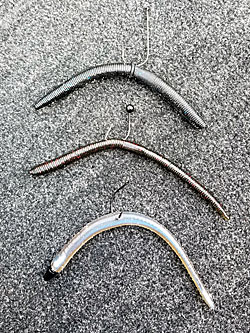
Choose 8-pound test line when fishing deeper spots and go up to 12- or 14-pound test if bass are still somewhat shallow. You’ll want a 7-foot or longer casting rod with a parabolic bend. It will help you throw them farther and absorb the shock of a fighting fish, keeping your trebles stuck. You don’t have to stick with a traditional slow-geared cranking reel. These baits don’t pull hard, so use a 6:1 or even 7:1 reel to help you cover more water.
Wacky style soft plastics
Sometimes, bass refuse to hit a moving lure regardless of what you do. It could be because of a cold front moving through. Or maybe too much fishing pressure has given them a case of lockjaw. These are the times when you need to scale back to finesse techniques. But most have to be worked slowly. Fortunately, there is one that allows you to cover water.
Wacky rigging has been around a long time. Its most basic form involves impaling a soft-plastic lure, usually some kind of worm, once through the middle with a hook. That leaves both ends free to move in the water. A weight is seldom used.
These shine when covering water because they can be pitched at targets. And once they’ve reached the bottom, they can be quickly reeled in and fired at the next piece of cover or structure. That means you can cover more water than, for example, hopping a Texas-rigged worm across the bottom.
The most popular lure to wacky rig is a stick worm such as a Gary Yamamoto Senko. Slimmer on one end, it creates plenty of action on the fall. But it’s not the only choice. Try a Neko rig if you need to fish deeper or get there quicker. It still uses a hook impaled through the center, but a nail-shaped weight is inserted in one end. That gives the worm a slightly different action.


